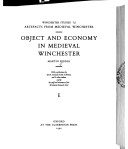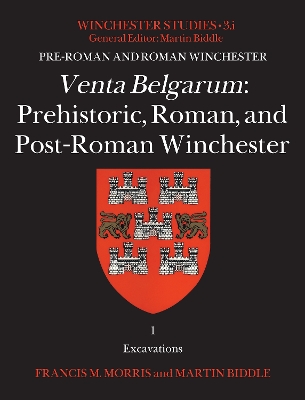Winchester Studies
3 total works
No.3ii
No.7ii
Using the objects as evidence for the economy of the medieval city, it also throws new light on some of the great questions of medieval industry and artistic production: amongst them the development of the textile industry, the origins of wire-drawing and the manufacture of pins, the beginnings of window-glass production, and the earliest glass painting. These objects are an essential part of the evidence for the development and changing character of the excavated sites to be published in forthcoming volumes of Winchester Studies on the Minsters. To ensure complete integration between the objects and the sites, every object in this volume is related to the context in which it was found and a concordance provides a detailed conspectus phase by phase of each of the twenty sites excavated between 1961-71, and of the objects found in each phase.
Venta Belgarum: Prehistoric, Roman, and Post-Roman Winchester
by Francis M Morris and Martin Biddle
This is a detailed study of the archaeology of Roman Winchester—Venta Belgarum, a major town in the south of the province of Britannia— and its development from the regional (civitas) capital of the Iron Age people, the Belgae, who inhabited much of what is now central and southern Hampshire. The archaeology of the Winchester area in prehistory is considered, and so too is the later evidence from the town, between the end of organized Roman life shortly after 400 and the foundation, c.650, of the church later known as Old Minster. At the heart of this account is the publication of the relevant phases of the sites excavated in 1961–71 by the Winchester Excavations Committee, and of the finds recovered from these excavations.
Volume 1 (Excavations) outlines previous work of relevance, and describes the WEC excavations and the post-excavation analysis of the discoveries, including full reports on the prehistoric, Roman, and post-Roman (to c.650) phases of the 14 sites excavated in 1961–71, with gazetteers for Roman Winchester, listing and describing all significant observations of the defences, and the streets and buildings within the walls.
Volume 2 (Finds) presents about 4000 of the finds from the excavations of 1961–71, with additional significant objects from earlier excavations in Winchester or other Winchester collections. Finds are described and discussed by era and type, with coins and selected pottery followed by objects grouped by industry or purpose. Concordances list these finds by site and phase or by material.


